engine TOYOTA TUNDRA 2011 2.G Manual PDF
[x] Cancel search | Manufacturer: TOYOTA, Model Year: 2011, Model line: TUNDRA, Model: TOYOTA TUNDRA 2011 2.GPages: 732, PDF Size: 16.65 MB
Page 262 of 732
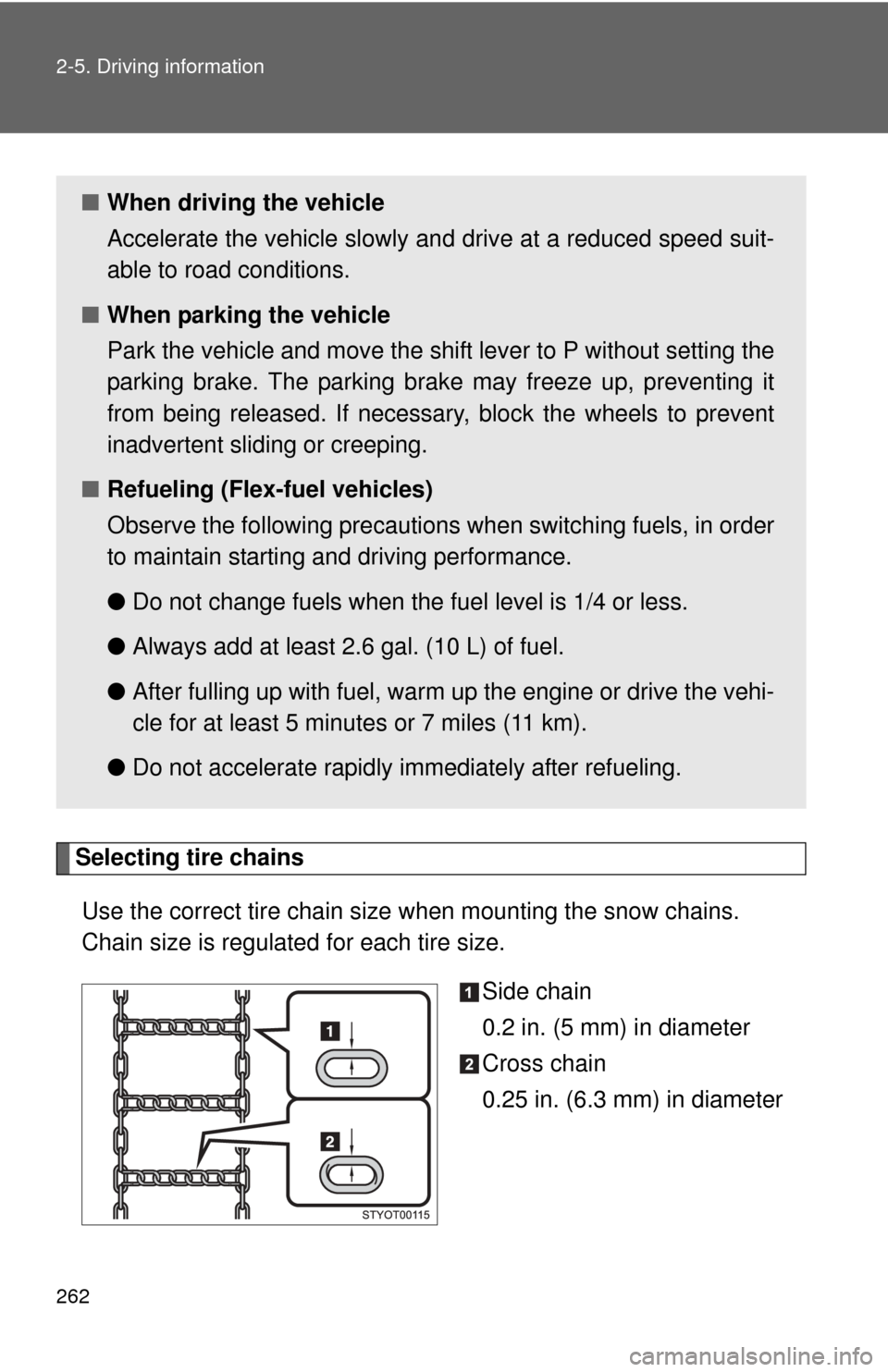
262 2-5. Driving information
Selecting tire chainsUse the correct tire chain size when mounting the snow chains.
Chain size is regulated for each tire size.
Side chain
0.2 in. (5 mm) in diameter
Cross chain
0.25 in. (6.3 mm) in diameter
■When driving the vehicle
Accelerate the vehicle slowly and drive at a reduced speed suit-
able to road conditions.
■ When parking the vehicle
Park the vehicle and move the shift lever to P without setting the
parking brake. The parking brak e may freeze up, preventing it
from being released. If necessary , block the wheels to prevent
inadvertent sliding or creeping.
■ Refueling (Flex-fuel vehicles)
Observe the following precautions when switching fuels, in order
to maintain starting and driving performance.
●Do not change fuels when the fuel level is 1/4 or less.
● Always add at least 2.6 gal. (10 L) of fuel.
● After fulling up with fuel, warm up the engine or drive the vehi-
cle for at least 5 minutes or 7 miles (11 km).
● Do not accelerate rapidly immediately after refueling.
Page 270 of 732
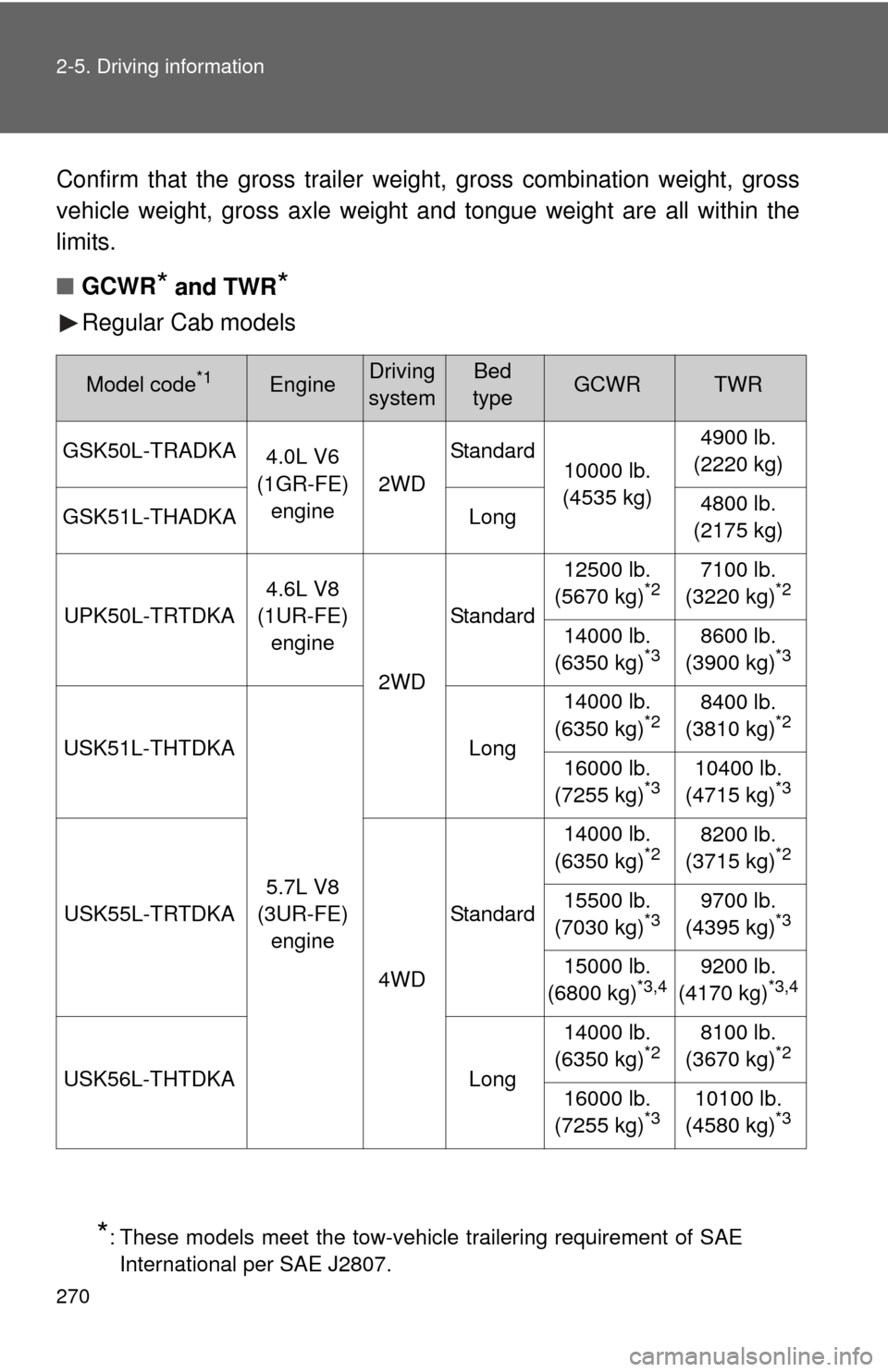
270 2-5. Driving information
Confirm that the gross trailer weight, gross combination weight, gross
vehicle weight, gross axle weight and tongue weight are all within the
limits.
■GCWR
* and TWR*
Regular Cab models
*: These models meet the tow-vehicle trailering requirement of SAE
International per SAE J2807.
Model code*1EngineDriving
systemBed
typeGCWRTWR
GSK50L-TRADKA 4.0L V6
(1GR-FE) engine 2WDStandard
10000 lb.
(4535 kg) 4900 lb.
(2220 kg)
GSK51L-THADKA Long 4800 lb.
(2175 kg)
UPK50L-TRTDKA 4.6L V8
(1UR-FE) engine
2WDStandard
12500 lb.
(5670 kg)
*27100 lb.
(3220 kg)*2
14000 lb.
(6350 kg)*38600 lb.
(3900 kg)*3
USK51L-THTDKA
5.7L V8
(3UR-FE) engine Long
14000 lb.
(6350 kg)
*28400 lb.
(3810 kg)*2
16000 lb.
(7255 kg)*310400 lb.
(4715 kg)*3
USK55L-TRTDKA
4WDStandard 14000 lb.
(6350 kg)
*28200 lb.
(3715 kg)*2
15500 lb.
(7030 kg)*39700 lb.
(4395 kg)*3
15000 lb.
(6800 kg)*3,49200 lb.
(4170 kg)*3,4
USK56L-THTDKA Long14000 lb.
(6350 kg)
*28100 lb.
(3670 kg)*2
16000 lb.
(7255 kg)*310100 lb.
(4580 kg)*3
Page 271 of 732
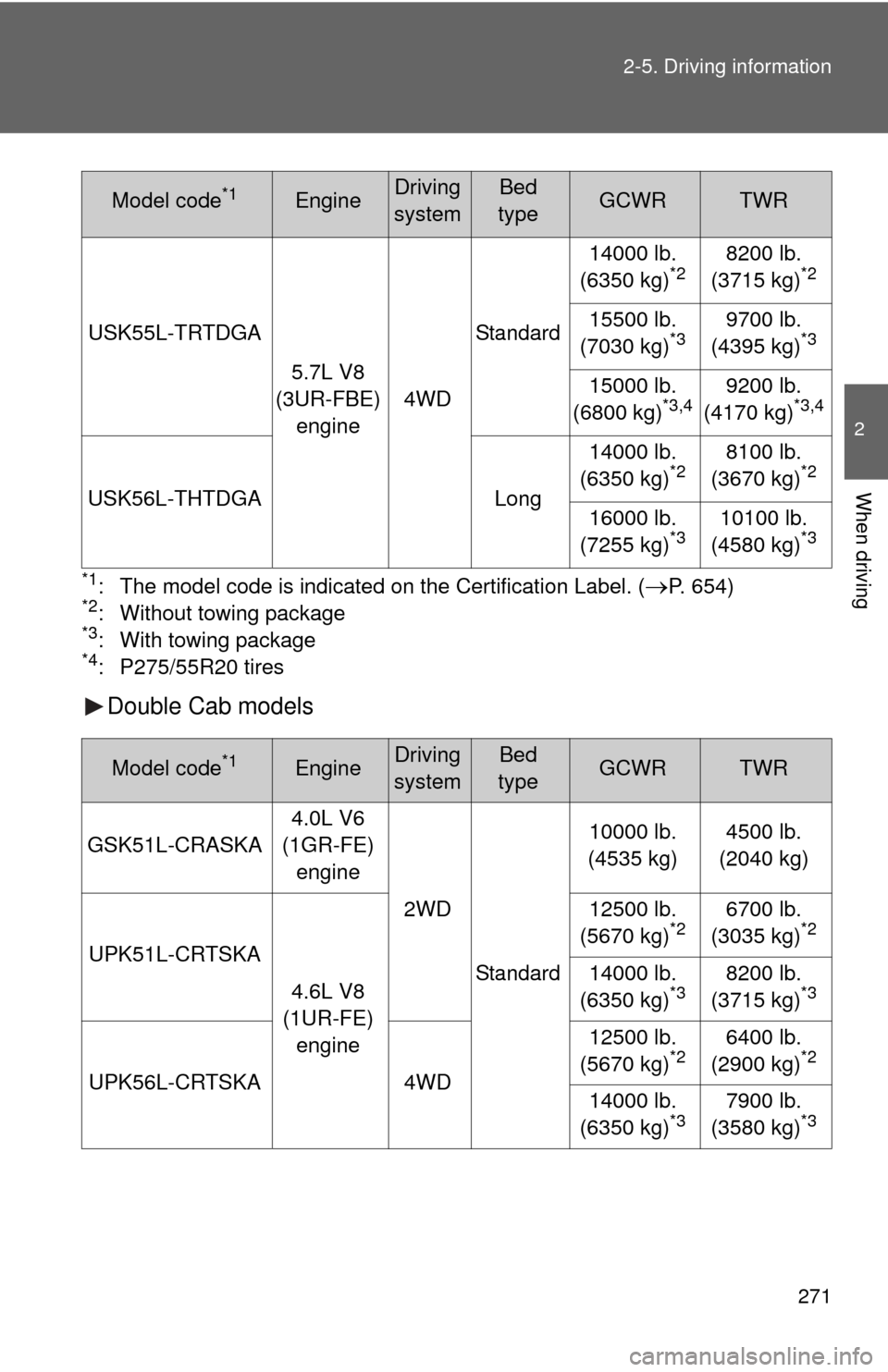
271
2-5. Driving information
2
When driving
*1: The model code is indicated on the Certification Label. (P. 654)*2: Without towing package*3: With towing package*4: P275/55R20 tires
Double Cab models
USK55L-TRTDGA
5.7L V8
(3UR-FBE) engine 4WDStandard 14000 lb.
(6350 kg)
*28200 lb.
(3715 kg)*2
15500 lb.
(7030 kg)*39700 lb.
(4395 kg)*3
15000 lb.
(6800 kg)*3,49200 lb.
(4170 kg)*3,4
USK56L-THTDGA Long14000 lb.
(6350 kg)
*28100 lb.
(3670 kg)*2
16000 lb.
(7255 kg)*310100 lb.
(4580 kg)*3
Model code*1EngineDriving
systemBed
typeGCWRTWR
GSK51L-CRASKA 4.0L V6
(1GR-FE) engine
2WD
Standard 10000 lb.
(4535 kg) 4500 lb.
(2040 kg)
UPK51L-CRTSKA 4.6L V8
(1UR-FE) engine 12500 lb.
(5670 kg)
*26700 lb.
(3035 kg)*2
14000 lb.
(6350 kg)*38200 lb.
(3715 kg)*3
UPK56L-CRTSKA 4WD12500 lb.
(5670 kg)
*26400 lb.
(2900 kg)*2
14000 lb.
(6350 kg)*37900 lb.
(3580 kg)*3
Model code*1EngineDriving
systemBed
typeGCWRTWR
Page 272 of 732
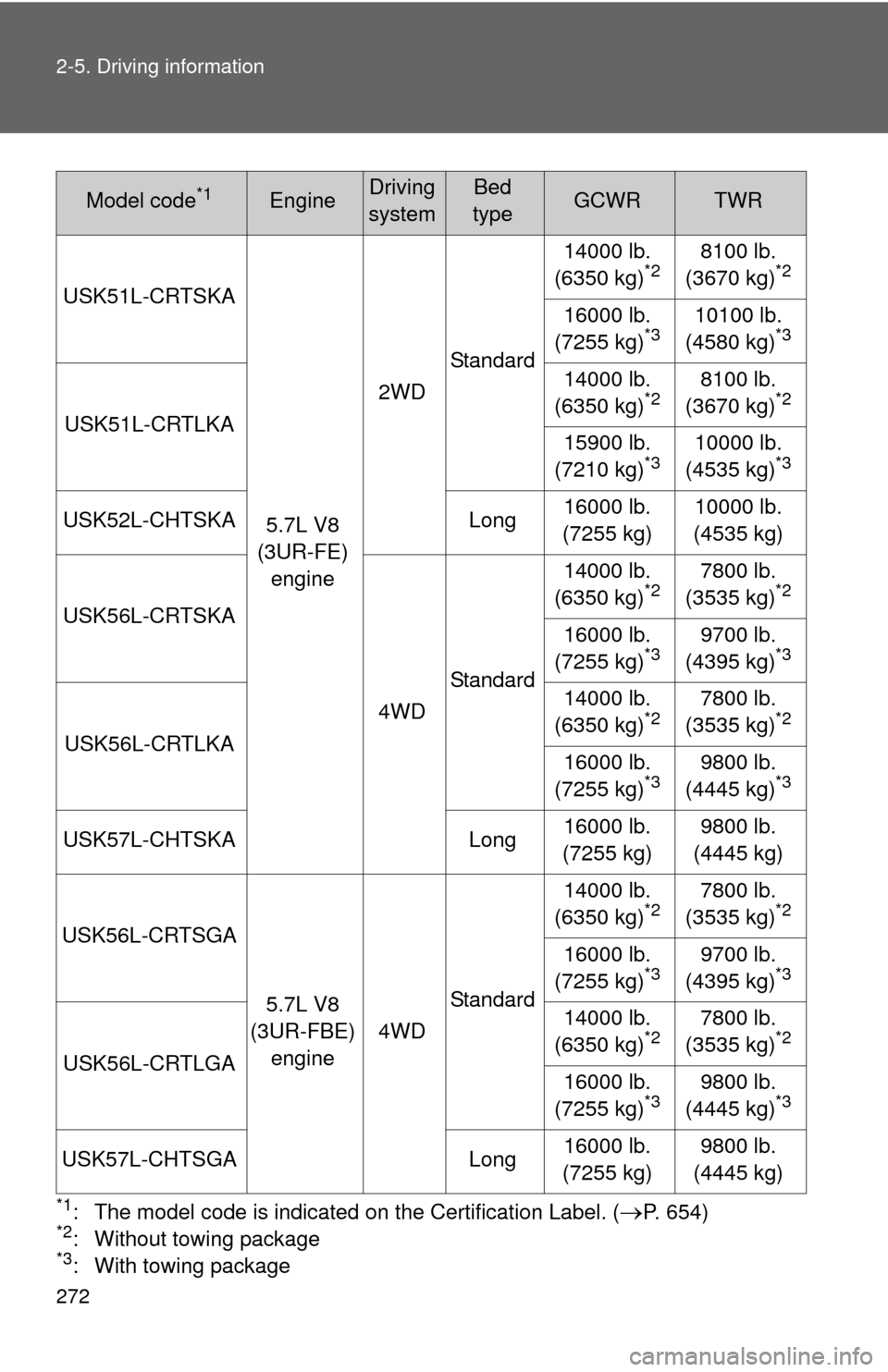
272 2-5. Driving information
*1: The model code is indicated on the Certification Label. (P. 654)*2: Without towing package*3: With towing package
USK51L-CRTSKA
5.7L V8
(3UR-FE) engine 2WD
Standard 14000 lb.
(6350 kg)
*28100 lb.
(3670 kg)*2
16000 lb.
(7255 kg)*310100 lb.
(4580 kg)*3
USK51L-CRTLKA 14000 lb.
(6350 kg)
*28100 lb.
(3670 kg)*2
15900 lb.
(7210 kg)*310000 lb.
(4535 kg)*3
USK52L-CHTSKA Long16000 lb.
(7255 kg) 10000 lb.
(4535 kg)
USK56L-CRTSKA
4WDStandard 14000 lb.
(6350 kg)
*27800 lb.
(3535 kg)*2
16000 lb.
(7255 kg)*39700 lb.
(4395 kg)*3
USK56L-CRTLKA 14000 lb.
(6350 kg)
*27800 lb.
(3535 kg)*2
16000 lb.
(7255 kg)*39800 lb.
(4445 kg)*3
USK57L-CHTSKA Long16000 lb.
(7255 kg) 9800 lb.
(4445 kg)
USK56L-CRTSGA 5.7L V8
(3UR-FBE) engine 4WDStandard 14000 lb.
(6350 kg)
*27800 lb.
(3535 kg)*2
16000 lb.
(7255 kg)*39700 lb.
(4395 kg)*3
USK56L-CRTLGA 14000 lb.
(6350 kg)
*27800 lb.
(3535 kg)*2
16000 lb.
(7255 kg)*39800 lb.
(4445 kg)*3
USK57L-CHTSGA Long16000 lb.
(7255 kg) 9800 lb.
(4445 kg)
Model code*1EngineDriving
systemBed
typeGCWRTWR
Page 273 of 732
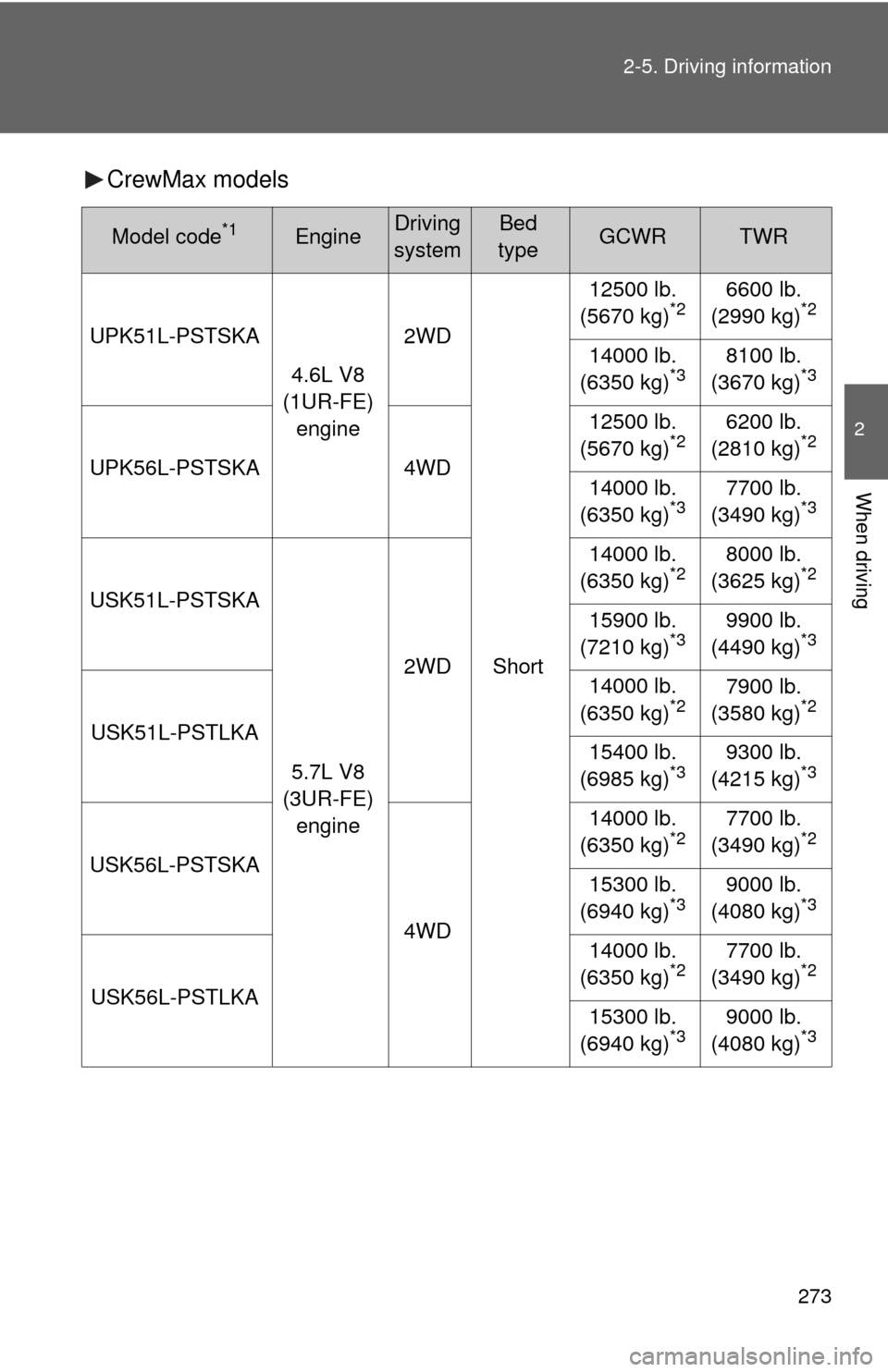
273
2-5. Driving information
2
When driving
CrewMax models
Model code*1EngineDriving
systemBed
typeGCWRTWR
UPK51L-PSTSKA 4.6L V8
(1UR-FE) engine 2WD
Short 12500 lb.
(5670 kg)
*26600 lb.
(2990 kg)*2
14000 lb.
(6350 kg)*38100 lb.
(3670 kg)*3
UPK56L-PSTSKA 4WD12500 lb.
(5670 kg)
*26200 lb.
(2810 kg)*2
14000 lb.
(6350 kg)*37700 lb.
(3490 kg)*3
USK51L-PSTSKA
5.7L V8
(3UR-FE) engine 2WD
14000 lb.
(6350 kg)
*28000 lb.
(3625 kg)*2
15900 lb.
(7210 kg)*39900 lb.
(4490 kg)*3
USK51L-PSTLKA 14000 lb.
(6350 kg)
*27900 lb.
(3580 kg)*2
15400 lb.
(6985 kg)*39300 lb.
(4215 kg)*3
USK56L-PSTSKA
4WD14000 lb.
(6350 kg)
*27700 lb.
(3490 kg)*2
15300 lb.
(6940 kg)*39000 lb.
(4080 kg)*3
USK56L-PSTLKA 14000 lb.
(6350 kg)
*27700 lb.
(3490 kg)*2
15300 lb.
(6940 kg)*39000 lb.
(4080 kg)*3
Page 274 of 732
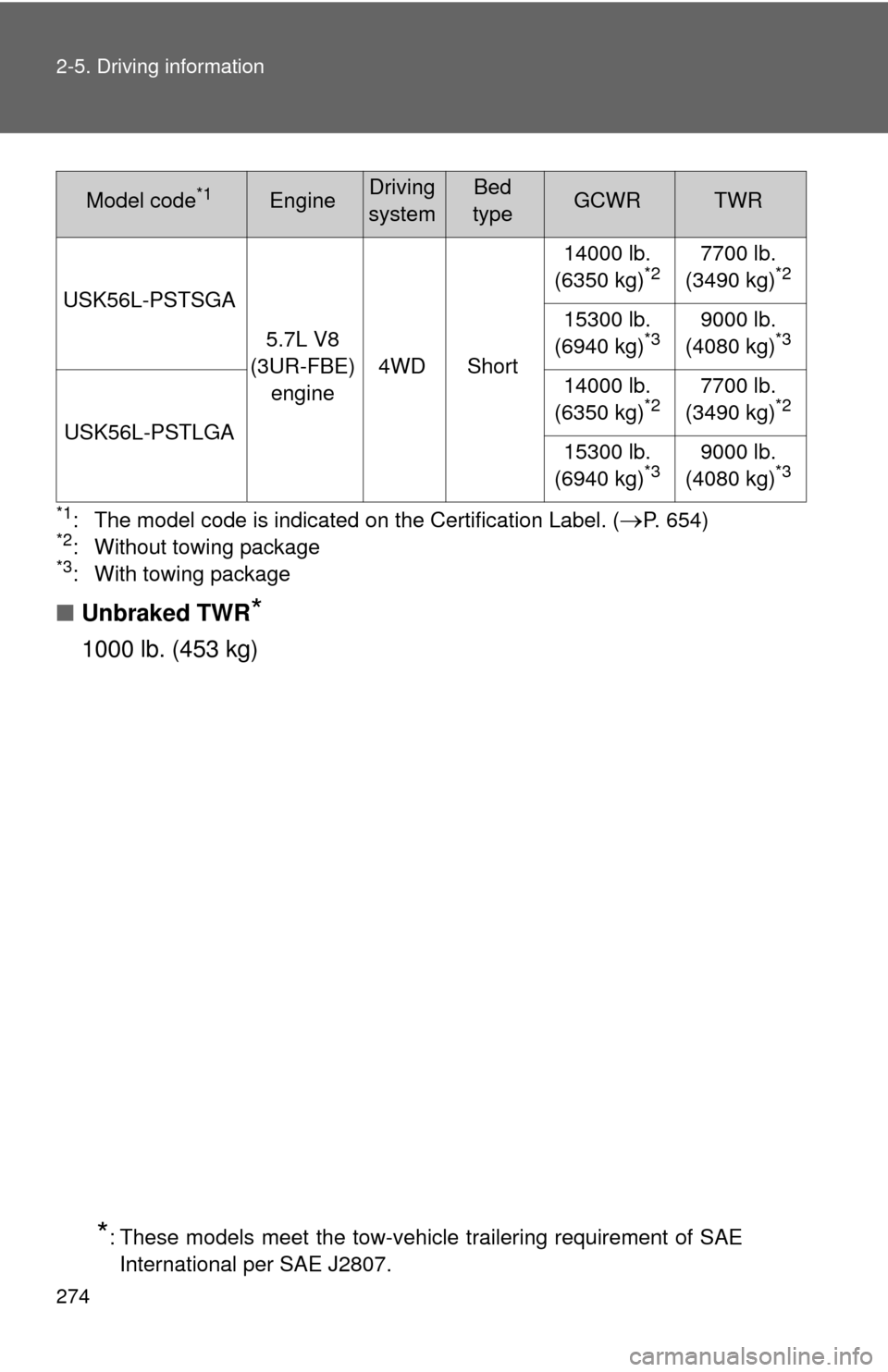
274 2-5. Driving information
*1: The model code is indicated on the Certification Label. (P. 654)*2: Without towing package*3: With towing package
■Unbraked TWR*
1000 lb. (453 kg)
USK56L-PSTSGA
5.7L V8
(3UR-FBE) engine 4WD Short 14000 lb.
(6350 kg)
*27700 lb.
(3490 kg)*2
15300 lb.
(6940 kg)*39000 lb.
(4080 kg)*3
USK56L-PSTLGA 14000 lb.
(6350 kg)
*27700 lb.
(3490 kg)*2
15300 lb.
(6940 kg)*39000 lb.
(4080 kg)*3
*: These models meet the tow-vehicle trailering requirement of SAE International per SAE J2807.
Model code*1EngineDriving
systemBed
typeGCWRTWR
Page 282 of 732
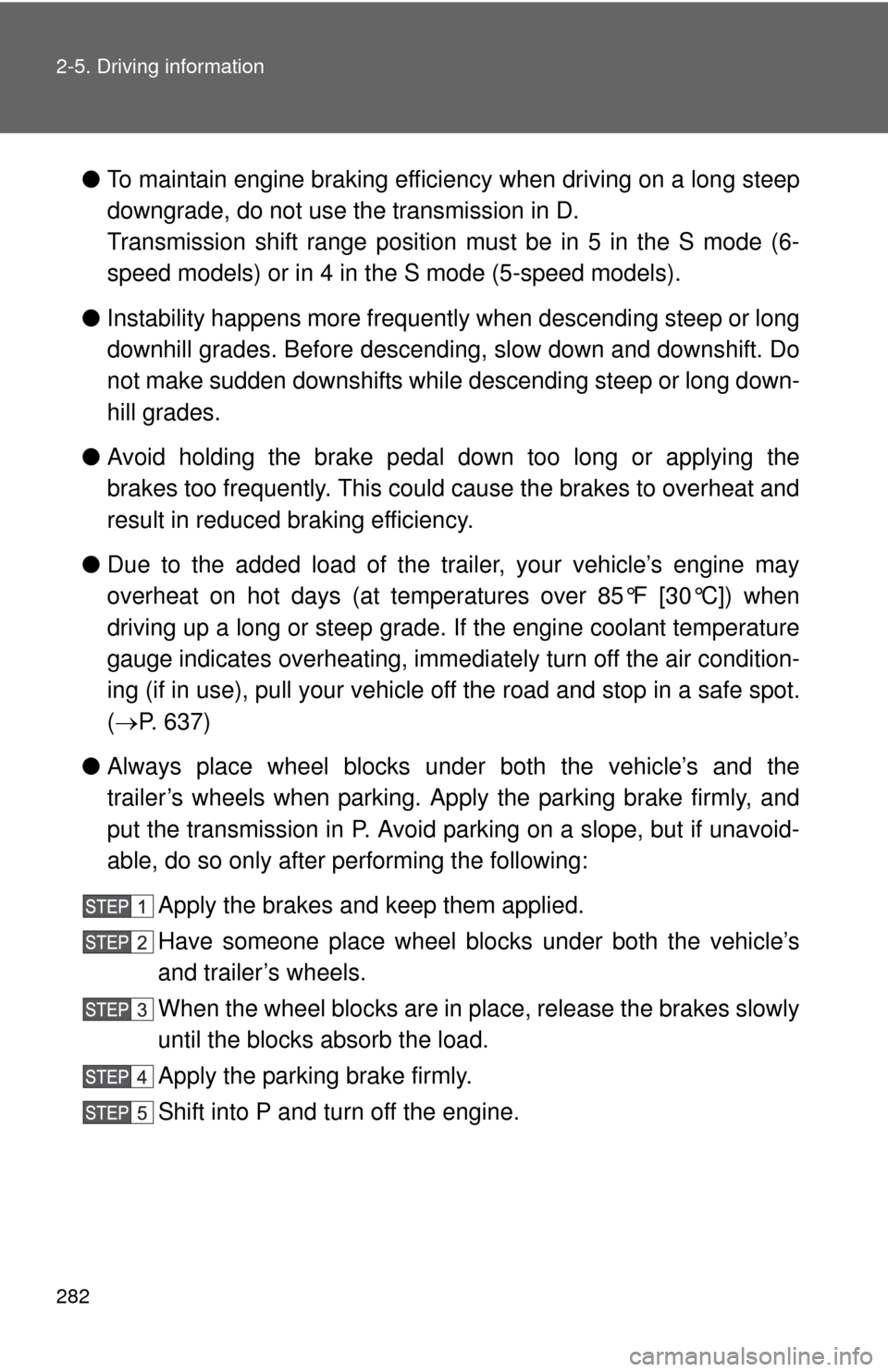
282 2-5. Driving information
●To maintain engine braking efficiency when driving on a long steep
downgrade, do not use the transmission in D.
Transmission shift range position must be in 5 in the S mode (6-
speed models) or in 4 in the S mode (5-speed models).
● Instability happens more frequently when descending steep or long
downhill grades. Before descending, slow down and downshift. Do
not make sudden downshifts while descending steep or long down-
hill grades.
● Avoid holding the brake pedal down too long or applying the
brakes too frequently. This could cause the brakes to overheat and
result in reduced braking efficiency.
● Due to the added load of the trailer, your vehicle’s engine may
overheat on hot days (at temper atures over 85°F [30°C]) when
driving up a long or steep grade. If the engine coolant temperature
gauge indicates overheating, immediately turn off the air condition-
ing (if in use), pull your vehicle off the road and stop in a safe spot.
( P. 637)
● Always place wheel blocks under both the vehicle’s and the
trailer’s wheels when parking. Ap ply the parking brake firmly, and
put the transmission in P. Avoid parking on a slope, but if unavoid-
able, do so only after performing the following:
Apply the brakes and keep them applied.
Have someone place wheel blo cks under both the vehicle’s
and trailer’s wheels.
When the wheel blocks are in place, release the brakes slowly
until the blocks absorb the load.
Apply the parking brake firmly.
Shift into P and turn off the engine.
Page 283 of 732
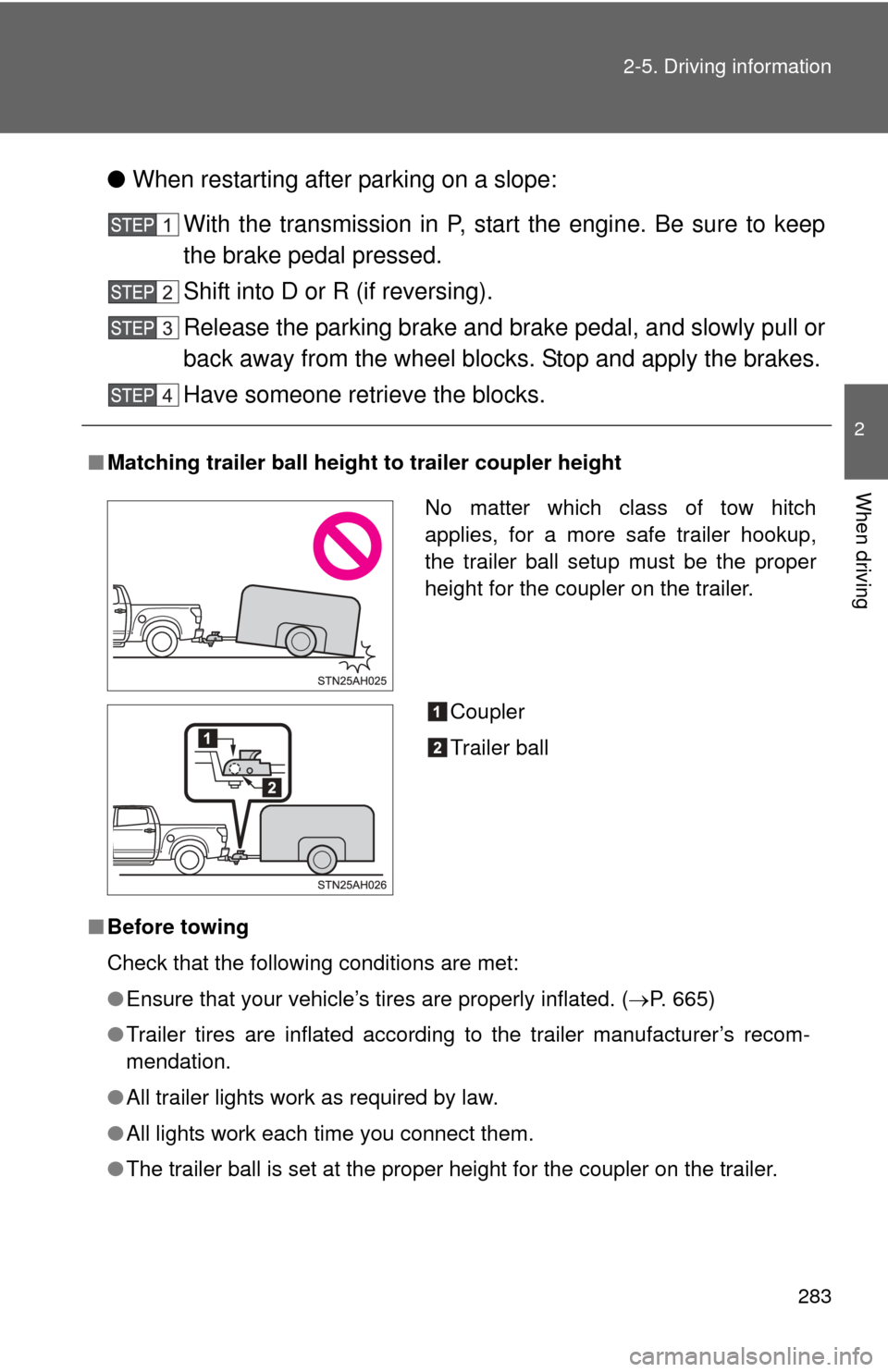
283
2-5. Driving information
2
When driving
●
When restarting after parking on a slope:
With the transmission in P, start the engine. Be sure to keep
the brake pedal pressed.
Shift into D or R (if reversing).
Release the parking brake and brake pedal, and slowly pull or
back away from the wheel blocks. Stop and apply the brakes.
Have someone retrieve the blocks.
■ Matching trailer ball height to trailer coupler height
■ Before towing
Check that the following conditions are met:
●Ensure that your vehicle’s tires are properly inflated. ( P. 665)
● Trailer tires are inflated according to the trailer manufacturer’s recom-
mendation.
● All trailer lights work as required by law.
● All lights work each time you connect them.
● The trailer ball is set at the proper height for the coupler on the trai\
ler.
No matter which class of tow hitch
applies, for a more safe trailer hookup,
the trailer ball setup must be the proper
height for the coupler on the trailer.
Coupler
Trailer ball
Page 284 of 732
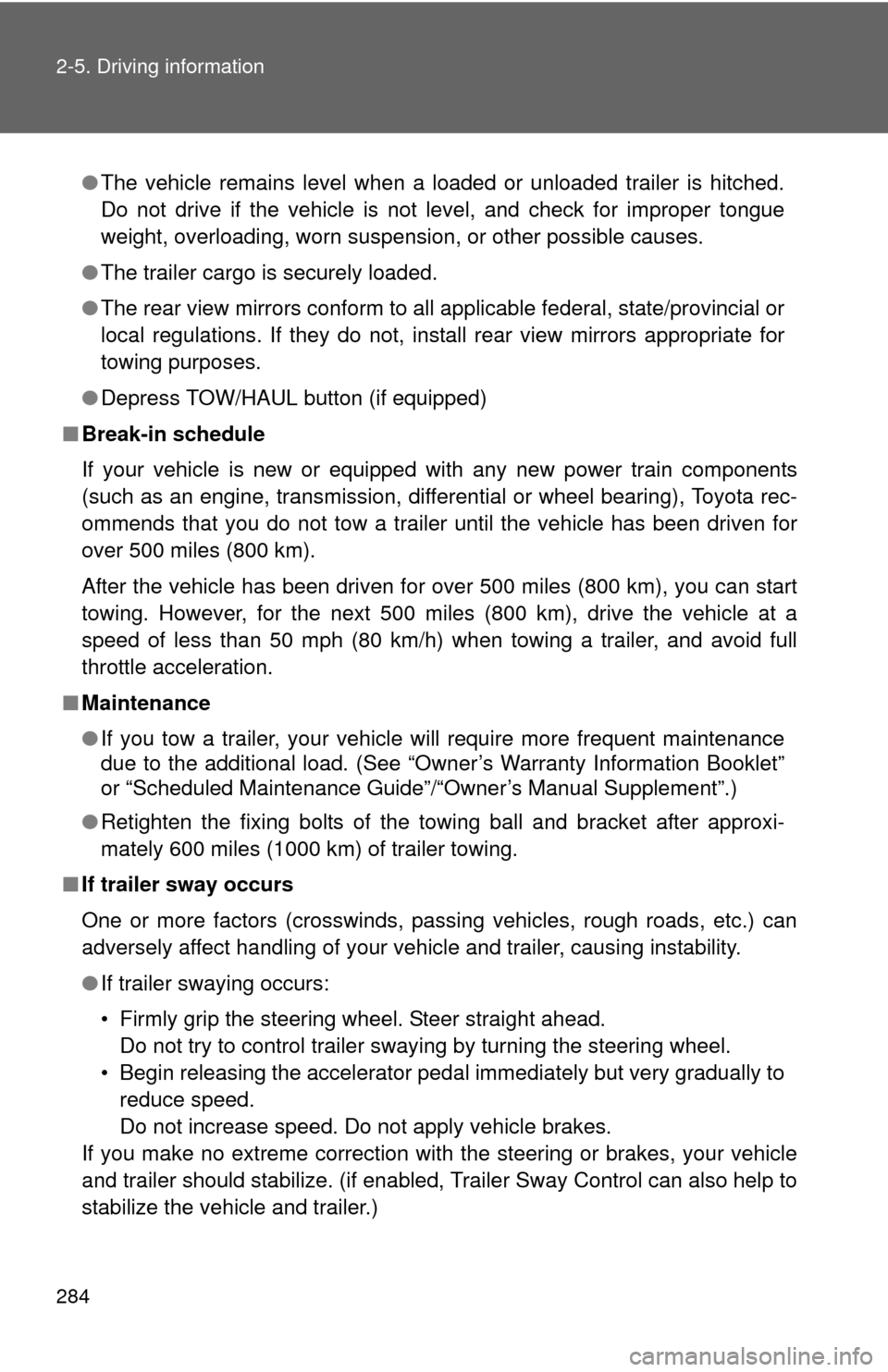
284 2-5. Driving information
●The vehicle remains level when a loaded or unloaded trailer is hitched.
Do not drive if the vehicle is not level, and check for improper tongue
weight, overloading, worn suspension, or other possible causes.
● The trailer cargo is securely loaded.
● The rear view mirrors conform to all applicable federal, state/provincial or
local regulations. If they do not, install rear view mirrors appropriate for
towing purposes.
● Depress TOW/HAUL button (if equipped)
■ Break-in schedule
If your vehicle is new or equipped with any new power train components
(such as an engine, transmission, differential or wheel bearing), Toyota rec-
ommends that you do not tow a trailer until the vehicle has been driven \
for
over 500 miles (800 km).
After the vehicle has been driven for over 500 miles (800 km), you can s\
tart
towing. However, for the next 500 miles (800 km), drive the vehicle at a
speed of less than 50 mph (80 km/h) when towing a trailer, and avoid full
throttle acceleration.
■ Maintenance
●If you tow a trailer, your vehicle will require more frequent maintenance
due to the additional load. (See “Owner’s Warranty Information Booklet”
or “Scheduled Maintenance Guide” /“Owner’s Manual Supplement”.)
● Retighten the fixing bolts of the towing ball and bracket after approxi-
mately 600 miles (1000 km) of trailer towing.
■ If trailer sway occurs
One or more factors (crosswinds, passing vehicles, rough roads, etc.) can
adversely affect handling of your vehicle and trailer, causing instability.
●If trailer swaying occurs:
• Firmly grip the steering wheel. Steer straight ahead.
Do not try to control trailer swaying by turning the steering wheel.
• Begin releasing the accelerator pedal immediately but very gradually to reduce speed.
Do not increase speed. Do not apply vehicle brakes.
If you make no extreme correction with the steering or brakes, your vehicle
and trailer should stabilize. (if enabled, Trailer Sway Control can also help to
stabilize the vehicle and trailer.)
Page 300 of 732
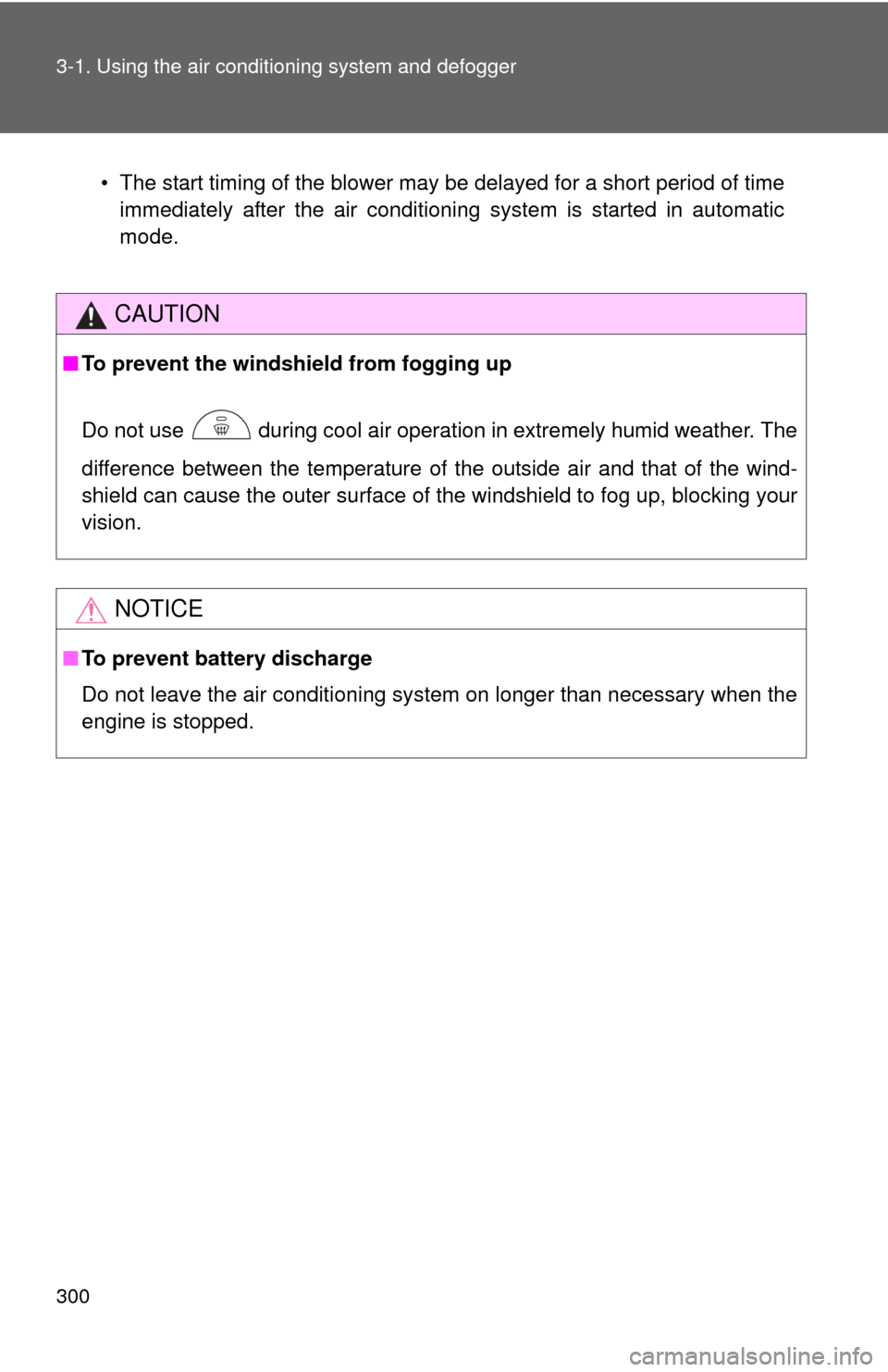
300 3-1. Using the air conditioning system and defogger
• The start timing of the blower may be delayed for a short period of time
immediately after the air conditioning system is started in automatic
mode.
CAUTION
■ To prevent the windshield from fogging up
Do not use during cool air operation in extremely humid weather. The
difference between the temperature of the outside air and that of the wind-
shield can cause the outer surface of the windshield to fog up, blocking your
vision.
NOTICE
■To prevent battery discharge
Do not leave the air conditioning system on longer than necessary when the
engine is stopped.